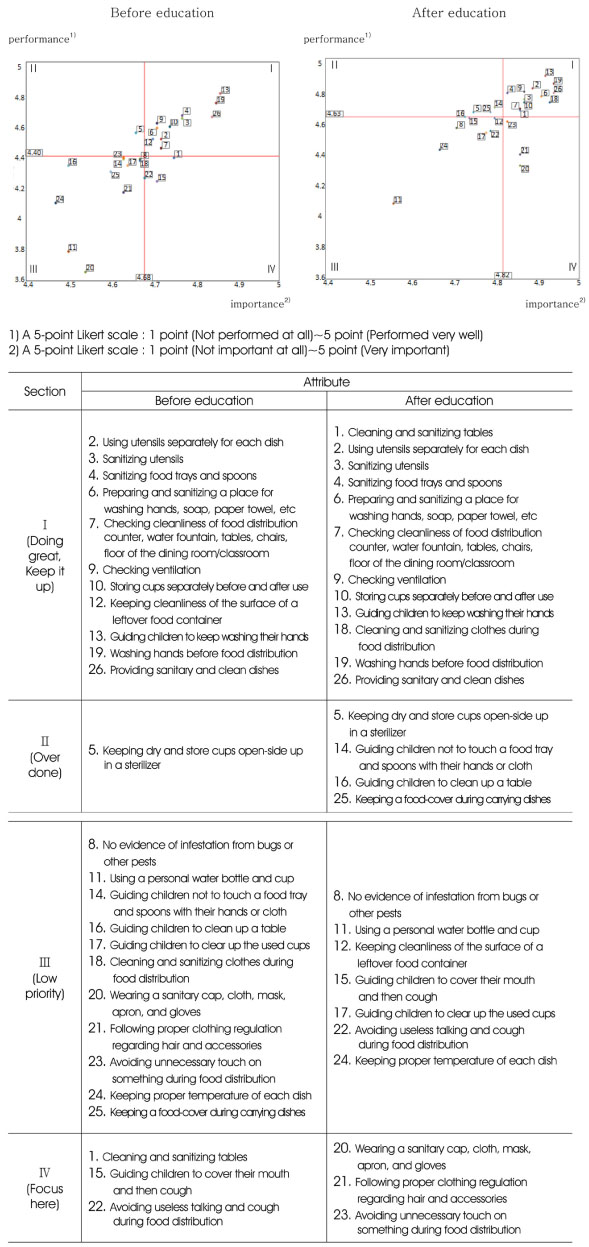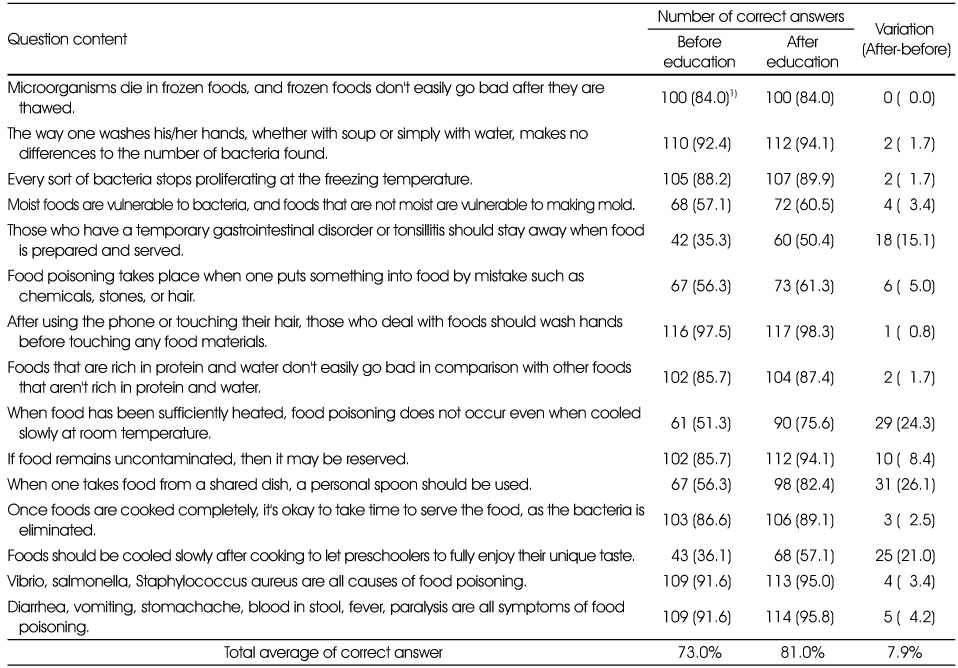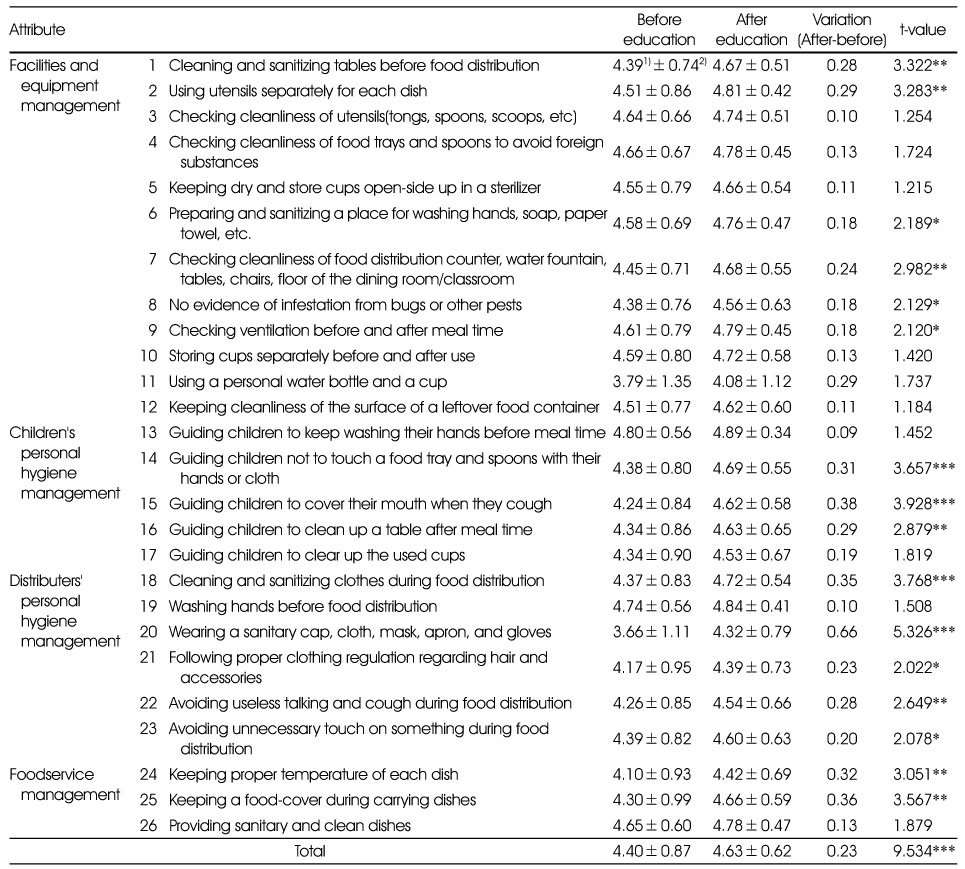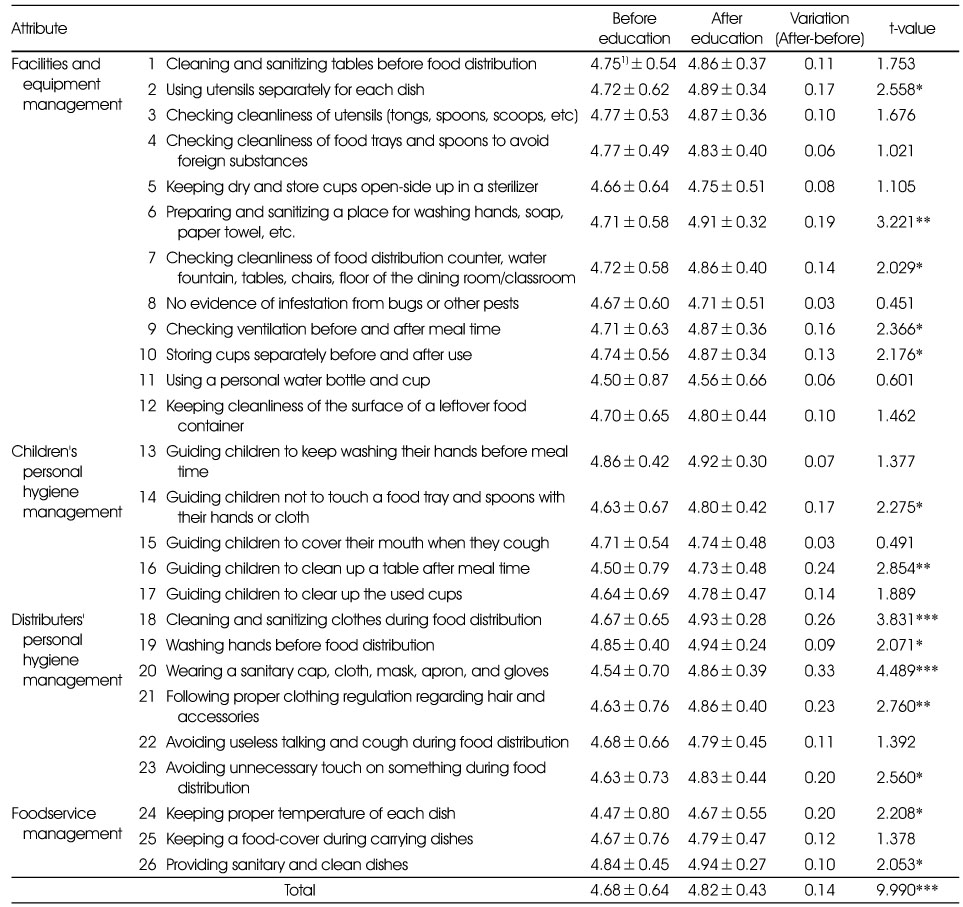Articles
- Page Path
- HOME > Korean J Community Nutr > Volume 20(6); 2015 > Article
-
Research Article
- Effects of an Education Program on Sanitation Status at Centers for Children's Food Service Management: Focusing on Jung-gu and Dong-gu regions of Daejeon Metropolitan City
- Yu-Jin Seo, Min-Sun Jeon
-
Korean Journal of Community Nutrition 2015;20(6):447-459.
DOI: https://doi.org/10.5720/kjcn.2015.20.6.447
Published online: December 31, 2015
Department of Food and Nutrition, Chungnam National University, Daejeon, Korea.
- Corresponding author: Min Sun Jeon. Department of Food and Nutrition, Chungnam National University, 99, Daehak-ro, Yuseong-gu, Daejeon 34134, Korea. Tel: 042-821-6836, Fax: (042) 821-8887, dearms@cnu.ac.kr
Copyright © 2015 The Korean Society of Community Nutrition
This is an Open-Access article distributed under the terms of the Creative Commons Attribution Non-Commercial License (http://creativecommons.org/licenses/by-nc/3.0/) which permits unrestricted non-commercial use, distribution, and reproduction in any medium, provided the original work is properly cited.
- 845 Views
- 2 Download
- 12 Crossref
Abstract
-
Objectives
- This study aimed to assess the improvement of teachers' sanitation performance and food distribution environment at Centers for children's food service management after a sanitation education program.
-
Methods
- The subjects were 119 teachers working at child care centers registered in the Daejeon Center for Children's Foodservice Management in Dongu and Jung-gu, Daejeon. The sanitation education was provided three times from March to August in 2014, and the survey questionnaires were distributed before and after the education. The sanitation status of food service environment of the centers was examined by ATP(adenosine-5'- triphosphate) bioluminescence.
-
Results
- After the sanitation education, the teachers showed higher levels of sanitation knowledge. Also, sanitation performance and recognition level of the importance of it significantly improved after the education program. The mean variation scores of importance and performance after the education were 0.14 and 0.23. According to the Importance-Performance Analysis (IPA) results of 26 sanitation attributes about the food service environment, the selection attributes with relatively low performance and importance were mostly distributed in the children's and distributer's personal hygiene management area. However, all attributes except using a personal water bottle and cup were moved to high performance and importance level. Also, the ATP examination results showed that the sanitation status of the food service environment was improved after the education program.
-
Conclusions
- The sanitation education program was effective in improving the recognition of the importance of sanitation and its performance with regard to food service management.
- 1. Yeoh Y, Kwon S, Yoon J. Teachers' participation and mealtime instruction in the food service at the Kwanak-gu childcare centers: comparison between child-care teachers caring different age groups, children younger than three years and those three years or older. Korean J Community Nutr 2013; 18(2): 112-124.Article
- 2. Ministry of Health and Welfare. 2014 childcare statistics [Internet]. Ministry of Health and Welfare; 2015; updated 2015 Apr 6]. cited 2015 Sep 21]. Available from: http://stat.mw.go.kr/.
- 3. Korean Educational Statistics Service. Education statistical year book [Internet]. Korean Educational Statistics Service; 2015; updated 2015 Aug 3]. cited 2015 Sep 30]. Available from: http://kess.kedi.re.kr/.
- 4. Bae HJ, Lee HY, Ryu K. Field assessment of food safety management at preschool foodservice establishments. Korean J Food Cookery Sci 2009; 25(3): 283-296.
- 5. Ministry of Food and Drug Safety. Food poisoning statistics [Internet]. Ministry of Food and Drug Safety; 2015; updated 2015 Jan 30]. cited 2015 Sep 11]. Available from: https://www.foodsafetykorea.go.kr/.
- 6. Lee KA, Lee MY, Park I. A survey on the hand washing awareness and behavior in elementary schools serving food in a classroom in Busan. J Korean Diet Assoc 2009; 15(3): 220-231.
- 7. Park HS, Lee KM, Seol HR, Park KH, Ryu K. Evaluation of foodservice managers' perception on safety management in childcare centers and kindergartens. Korean J Community Nutr 2009; 14(1): 87-99.
- 8. Lee JY. A survey on hygienic perception of students about elementary school food service in Seoul [master's thesis]. Kyunghee University; 2011.
- 9. Choi KS. A study on nutrition knowledge, dietary attitudes and nutrition education needs among child-care teachers. Korean J Community Nutr 2010; 15(1): 137-148.
- 10. Choi DM. 2015 center for children's foodservice management guide-line. 1st revision. Cheongwon: Ministry of Food and Drug Safety; 2015. p. 3-9.
- 11. Center for Children's Foodservice Management. Center introduction [Internet]. Ministry of Food and Drug Safety; 2015; updated 2011 Jun 24]. cited 2015 Sep 30]. Available from: https://ccfsm.foodnara.go.kr/.
- 12. Kim J, Lee Y. The effect of a periodic visiting education program on food safety knowledge of cooks in children's foodservice facilities. J Korean Diet Assoc 2014; 20(1): 36-49.Article
- 13. Kim HY, Yang IS, Chae IS, Yi BS, Park MK, Kim HY. Effectiveness of center for child-care foodservice management for menu management and dietary variety. Korean J Community Nutr 2013; 18(3): 243-256.Article
- 14. Jung HA, Kim AN, Joo NM, Paik JE. Analyzing the importance and performance of sanitation management within childcare center foodservice facilities in Gyeongbuk province. J East Asian Soc Diet Life 2011; 21(3): 385-391.
- 15. Jang JY. Teacher awareness and needs on dietary education at child care centers and kindergartens located in Seoul [master's thesis]. Graduate School of Education Kyunghee University; 2011.
- 16. Lee JE, Choi KS, Kwak TK. Assessment of kindergarten principals and teachers' performance degree of foodservice hygiene management and foodservice employees' hygiene knowledge. J Korean Diet Assoc 2012; 18(4): 308-325.Article
- 17. Choi NR. Survey on secondary school teachers' awareness for sanitation in school meal service(Focused on Daegu and GyeongBuk area) [master's thesis]. Graduate School of Education Yeungnam University; 2010.
- 18. Seo S, Moon S, Choi J. Evaluation of hygienic status using ATP bioluminescence assay and food service workers' sanitation performance in elderly welfare facilities. J Korean Diet Assoc 2011; 17(2): 142-160.
- 19. Kim JB, Hur ES, Kang SH, Kim DH, Do YS, Park PH, et al. Prevalence of microbiological hazard on nursery school children's hands and effect of hand washing education. J Food Hyg Saf 2012; 27(1): 30-36.Article
- 20. Park SJ, Ha GS, Shim WB, Park MK, Chung DH. Environmental Microbial Assessment of Food Services at Elementary School in Western Gyeongnam Province. J Food Hyg Saf 2003; 18(1): 14-24.
REFERENCES
Figure & Data
REFERENCES
Citations

- 일부 학교급식 위생관리 컨설팅을 통한 개선사항 도출 연구
해림 조, 서진 김, 중범 김, 수연 김
Korean Journal of Food and Cookery Science.2025; 41(3): 151. CrossRef - Relationship with the Perception of Foodservice, Nutritional Knowledge, and Foodservice Guidance of Day-Care Center Teachers in Gangwon Area
Seung-Lim Lee
Journal of the East Asian Society of Dietary Life.2024; 34(3): 203. CrossRef - Relationship between the Nutrition Quotient, Sustainable Diets, and Meal Guidance of Day-Care Center Teachers according to the Type of Day-Care Center : Focus on the Gangwon Area
Seung-Lim Lee, Ji-Hye Kim, Hye-Ji Oh, Myeong-Jong Kim
Journal of the East Asian Society of Dietary Life.2024; 34(4): 262. CrossRef - A Study of Food Safety Knowledge for Sustainable Foodservice Management of Childcare Centers in South Korea Using Importance–Performance Analysis
Jeong-Sil Choi, Se-Young Ju
International Journal of Environmental Research and Public Health.2022; 19(15): 9668. CrossRef - Evaluation of Food Safety Management Status of Children’s Foodservice Facilities Using Sanitary Check Scores and ATP Bioluminescence Assay in Gyoengbuk Area
Kyung-A Lee
Journal of the Korean Society of Food Science and Nutrition.2021; 50(2): 196. CrossRef - Comparison of Salinity and Sodium Content by the Salinity Measurement Frequency of Soups of Childcare Centers Enrolled in the Center for Children's Food Service Management in Daegu
Na-Yeong Lee, Yeon-Kyung Lee
Korean Journal of Community Nutrition.2020; 25(1): 13. CrossRef - Research trends in obesity & obesogenic environments in Korea
Myoungsook Lee
Nutrition Research and Practice.2019; 13(6): 461. CrossRef - Effects of Periodic Visiting Education Support on the Sanitation Management of Foodservice Facilities for Children in the Local Small City: A Focus on the Yecheon-gun Area
Hye-Jin Pak, Chan-Ick Cheigh
Food Engineering Progress.2019; 23(3): 200. CrossRef - Analysis of Sanitary Safety Management Improvement for Children’s Food service in Chilgok-gun Area
Suk-Hyeon Park, Hyeon-A Jung
Journal of the East Asian Society of Dietary Life.2018; 28(5): 345. CrossRef - The Effect of Personality Type and Job Performance on Emotional Exhaustion and Job Satisfaction - Staff of the Center for Children's foodservice management -
Kyung-Min Lee, Min-Sun Jeon
Korean Journal of Community Nutrition.2018; 23(6): 496. CrossRef - A study on the optimal variable transformation method to identify the correlation between ATP and APC
Hye-Kyung Moon, Jae-Kyoung Shin, Yang Sook Kim
Journal of the Korean Data and Information Science Society.2016; 27(6): 1465. CrossRef - A Comparison of Hygiene and Safety Management Execution depending on the Characteristics of Children's Food Service Facilities
Jin-Young Lee
The Korean Journal of Food And Nutrition.2016; 29(4): 573. CrossRef

Fig. 1
Demographic information of the teachers
1) Multiple choice allowed
Levels of sanitation knowledge among the teachers
1) N (%)
Levels of sanitation performance among teachers
1) A 5-point Likert scale : 1 point (Not performed at all)~5 point (Performed very well)
2) Mean±SD
*: p < 0.05, **: p < 0.01, ***: p < 0.001
Levels of sanitation importance among teachers
1) A 5-point Likert scale : 1 point (Not important at all)~5 point (Very important)
2) Mean±SD
*: p < 0.05, **: p < 0.01, ***: p < 0.001
Microbiological qualities of the food distribution environment by ATP bioluminescence method (Unit : RLU/cm2)
1) Mean±SD
*: p < 0.05, **: p < 0.01, ***: p < 0.001
1) Multiple choice allowed
1) N (%)
1) A 5-point Likert scale : 1 point (Not performed at all)~5 point (Performed very well) 2) Mean±SD *: p < 0.05, **: p < 0.01, ***: p < 0.001
1) A 5-point Likert scale : 1 point (Not important at all)~5 point (Very important) 2) Mean±SD *: p < 0.05, **: p < 0.01, ***: p < 0.001
1) Mean±SD *: p < 0.05, **: p < 0.01, ***: p < 0.001

 KSCN
KSCN






 PubReader
PubReader Cite
Cite


